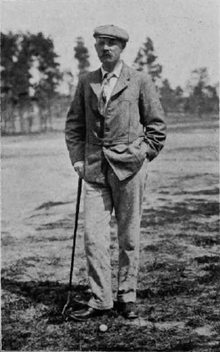Donald Ross
Donald James Ross (born November 23, 1872 in Dornoch , † April 26, 1948 in Pinehurst ) was a Scottish golf architect, main representative of the golden age of golf architecture and one of the most productive golf architects of that time with at least 413 new golf courses.
Life
The Scot Donald James Ross grew up on the links of Royal Dornoch and began his career there as a greenkeeper. After a year of training at Old Tom Morris in St Andrews, he returned to Dornoch in 1893. In 1899, Harvard professor Robert Wilson convinced him to emigrate to the USA. This also got him his first job at Oakley Golf Club near Boston . Ross redesigned the square and designed several more in the area. A year later he met businessman James Walker Tufts , who hired him for his new Pinehurst resort in North Carolina .
There he built a total of four places in the course of his career. The most important of these is Pinehurst # 2, which he continued to refine over the next few decades. In 1935, Ross introduced greens made from Bermuda grass as the crowning glory of his design work - previously oiled sand greens were common in the southern United States due to the drought . He was the first golf architect to hire assistants and with their help expanded his “architectural empire” across the United States. In the 1920s, some 3000 employees were working on the construction of its golf courses. Ross never saw about a third of his designs, and he visited another third at most once or twice. He worked mainly from his cabin behind the third green in Pinehurst, using topographical maps and written instructions to his construction crews.
His trademark were curved plateau greens, which were usually open at the front, but allowed a less than perfect approach stroke to roll in all directions, as Ross cut the grass very short in the edge area. This concept of the "short grass slope" is still used today in large tournaments, as modern professional players can control the typical obstacles on the green - bunkers or rough - much better than inclined embankments and inclines that are difficult to assess.
Ross paid special attention to the routing, so that only short distances had to be covered between the green and the next tee. Its spaces appear harmonious and often even inconspicuous, also due to the economical but targeted bunkering. Occasionally he even made use of the Cross Bunker, actually a relic from the Victorian period, which, however, could not hold up against modern views on most of the Ross-Platz.
His most famous courses include Pinehurst # 2 (1903), the Worcester Country Club in Massachusetts (1913), Wannamoisett (1914), East Lake in Atlanta (1915), Plainfield Country Club in New Jersey (1916), Scioto (1916), Essex County in Massachusetts (1917), Oakland Hills (1918), Inverness in Toledo (1919), Interlachen (1921), Salem in Massachusetts (1925), Oak Hill near Rochester (1926), Holston Hills near Knoxville (1928) and Seminole in Florida (1929).
A year before his death, Donald Ross founded the American Society of Golf Course Architects with 13 colleagues including Robert Trent Jones , William Langford, Perry Maxwell and Stanley Thompson and became its first president. In 1977 he was inducted into the World Golf Hall of Fame .
literature
- Bradley S. Klein: Discovering Donald Ross . John Wiley & Sons Inc, Hoboken 2001, ISBN 1886947554
- Geoffrey S. Cornish , Ronald E. Whitten: The Architects of Golf . HarperCollins, New York 1993, ISBN 0062700820
Web links
| personal data | |
|---|---|
| SURNAME | Ross, Donald |
| ALTERNATIVE NAMES | Ross, Donald James (full name) |
| BRIEF DESCRIPTION | Scottish golf architect |
| DATE OF BIRTH | November 23, 1872 |
| PLACE OF BIRTH | Dornoch |
| DATE OF DEATH | April 26, 1948 |
| Place of death | Pinehurst |
